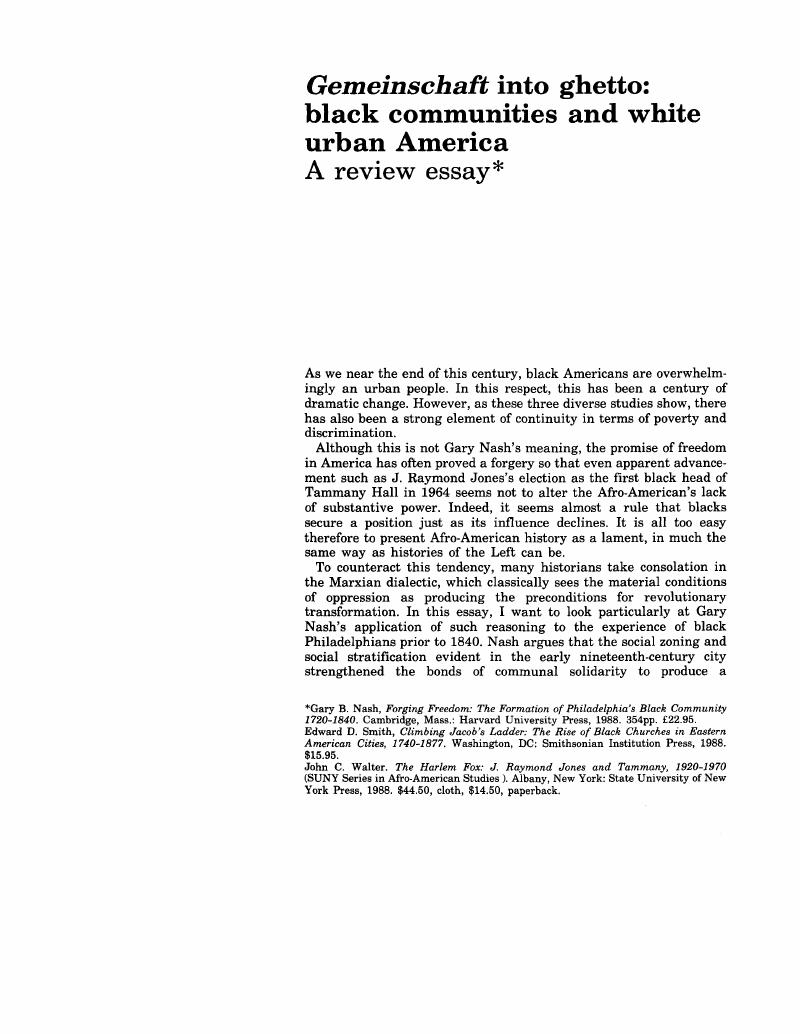No CrossRef data available.
Article contents
Gemeinschaft Into Ghetto: Black Communities and White Urban America
A review essay*
Published online by Cambridge University Press: 09 February 2009
Abstract

- Type
- Review Article
- Information
- Copyright
- Copyright © Cambridge University Press 1991
Footnotes
Gary B. Nash, Forging Freedom: The Formation of Philadelphia's Black Community 1720–1840. Cambridge, Mass.: Harvard University Press, 1988. 354pp. £22.95.
Edward D. Smith, Climbing Jacob's Ladder: The Rise of Black Churches in Eastern American Cities, 1740–1877. Washington, DC: Smithsonian Institution Press, 1988. $15.95.
John C. Walter. The Harlem Fox: J. Raymond Jones and Tammany, 1920–1970 (SUNY Series in Afro-American Studies ). Albany, New York: State University of New York Press, 1988. $44.50, cloth, $14.50, paperback.
References
Notes
1 Nash, Gary B., “The social evolution of pre-industrial American cities, 1700–1820: reflections and new directions”, Journal of Urban History, 13 (1987), 115–45. Nash discusses Tonnies' ‘gemeinschaft/gesellschaft’ distinction, 116–19.CrossRefGoogle Scholar
2 Nash, Gary B., Quakers and Politics: Pennsylvania, 1681–1726 (1968).Google Scholar
3 Nash, Gary B., The Urban Crucible: Social Change, Political Consciousness, and the Origins of the American Revolution (1979).Google Scholar
4 Nash, Gary B., Red, White, and Black: The Peoples of Early America (1974).Google Scholar
5 Nash, , ‘Social evolution’, 122.Google Scholar
6 Nash, , Forging Freedom, 272–3.Google Scholar
7 Curry, Leonard P., The Free Black in Urban America, 1800–1850: The Shadow of the Dream (1981), 21, 39, appendices B & C.Google Scholar
8 Nash, , Forging Freedom, 247–8.Google Scholar
9 Nash, , ‘Social evolution’, 131;Google Scholar cf. Lapsansky, Emma J., ‘“Since they got those separate churches”: Afro-Americans and racism in Jacksonian Philadelphia’, American Quarterly, 32 (Spring 1980), 54–78.Google Scholar
10 Woodward, C. Vann, The Strange Career of Jim Crow (2nd edn, 1966), 17–21.Google Scholar
11 Nash, , Forging Freedom, 223.Google Scholar
12 Wilmore, Gayraud S., Black Religion and Black Radicalism: An Interpretation of the Religious History of the Afro-American People (1972), 114Google Scholar
13 Morris, Aldon, The Origins of the Civil Rights Movement (1984) and Doug McAdam, Political Process and the Development of Black Insurgency, 1930–1970 (1982).Google Scholar
14 Frazier, E. Franklin, ‘Human, all too human: the negro's vested interest in segregation’ (1964), and ‘The impact of urban civilization upon negro family life’ (1936) in E. Franklin Frazier On Race Relations (1968).Google Scholar
15 Nash, , Forging Freedom, 114.Google Scholar
16 Forging Freedom, 191–202; 228–33; 260–7;Google Scholar Smith, , Climbing Jacob's Ladder, chapter 3.Google Scholar
17 Smith, , Climbing Jacob's Ladder, 44–5.Google Scholar
18 Climbing Jacob's Ladder, chapters 4 and 5.Google Scholar
19 Nash, Forging Freedom, 233–45, 278.Google Scholar
20 Curry, , Free Black, 219–20.Google Scholar
21 O'Riordan, William, Plunkitt of Tammany Hall (1948).Google Scholar
22 Walter, , Harlem Fox, 140–50.Google Scholar
23 Jones prefers the term ‘silk stockings’,Walter, , Harlem Fox, 215–19.Google Scholar
24 Harlem Fox, 201–13.Google Scholar
25 Harlem Fox, 24753.Google Scholar




